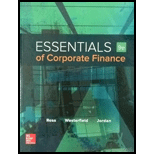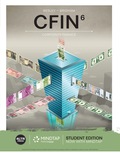
Concept explainers
Calculating Net Float. Each business day, on average, a company writes checks totaling $23,400 to pay its suppliers. The usual clearing time for the checks is four days. Meanwhile, the company is receiving payments from its customers each day, in the form of checks, totaling $38,100. The cash from the payments is available to the firm after two days.
a. Calculate the company’s disbursement float, collection float, and net float.
b. How would your answer to part (a) change if the collected funds were available in one day instead of two?
a)
To determine: The disbursement, collection, and net floats of the firm.
Introduction:
Float is the difference between the bank cash and the book cash, denoting the net effects of checks during the clearing process.
Disbursement float is a condition where the company’s book balance is lower than the available cash balance.
Collection float is a condition where the company’s book balance is higher than the available cash balance.
Answer to Problem 6QP
The disbursement float is $93,600.
The collection float is −$76,200.
The net float is $17,400.
Explanation of Solution
Given information:
A firm writes a total check of $23,400 for the supplier’s payment. The clearing time for the check is 4 days. The payments obtained every day from the customer, by the company (through checks), is $38,100. However, the payment of cash to the company is available after two days.
The formula to calculate the disbursement float:
The formula to calculate the collection float:
The formula to calculate the net float:
Compute the disbursement float:
Hence, the disbursement float is $93,600.
Compute the collection float:
Hence, the collection float is −$76,200.
Calculate the net float:
Hence, the net float is $17,400.
b)
To determine: The disbursement, collection, and net floats of the firm if the collected funds were available in one day.
Answer to Problem 6QP
The disbursement is $93,600.
The collection float is −$38,100.
The net float of the firm if the collected funds were available in one day is $55,500.
Explanation of Solution
Given information:
A firm writes a total check of $23,400 for the supplier’s payment. The clearing time for the check is 4 days. The payments obtained every day from the customer, by the company (through checks), is $38,100. However, the payment of cash to the company is available after one day.
The formula to calculate the disbursement float:
The formula to calculate the collection float:
The formula to calculate the net float:
Compute the disbursement float:
Hence, the disbursement float is $93,600.
Compute the collection float:
Hence, the collection float is −$38,100.
Calculate the net float:
Hence, the net float is $55,500.
Want to see more full solutions like this?
Chapter 17 Solutions
Essentials of Corporate Finance (Mcgraw-hill/Irwin Series in Finance, Insurance, and Real Estate)
- What is the duration of a four-year Treasury bond with a 10 percent semiannual coupon selling at par?arrow_forwardDon't used Ai solutionarrow_forwardYou bought a bond five years ago for $935 per bond. The bond is now selling for $980. It also paid $75 in interest per year, which you reinvested in the bond. Calculate the realized rate of return earned on this bond. I want to learn how to solve this on my financial calculator. Can you show me how to solve it through there.arrow_forward
- What are the Cases Not Readily Bound and what is a Dignity in a Research Study? What are the differences between Dignity in a Research Study and Cases Not Readily Bound? Please help to give examples.arrow_forwardWhat are the Case Study Research Design Components. Please help to give examplesWhat are the Case Study Design Tests and Tactics and how would they do?arrow_forwardDescribe some different types of ratios and how they are used to assess performance. Explain the components of the formula and the order of operations to calculate them. Discuss what these ratios say about the financial health of the organization. Determine why it is sometimes misleading to compare a company's financial ratios with those of other firms that operate within the same industry.arrow_forward
- Is there retained earning statement an important financial statement at the income statement and or the cash flows statement?arrow_forward2-13. (Term structure of interest rates) You want to invest your savings of $20,000 in government securities for the next 2 years. Currently, you can invest either in a secu- rity that pays interest of 8% per year for the next 2 years or in a security that matures in 1 year but pays only 6% interest. If you make the latter choice, you would then reinvest your savings at the end of the first year for another year. Why might you choose to make the investment in the 1-year security that pays an interest rate of only 6%, as opposed to investing in the 2-year security pay- ing 8%? Provide numerical support for your answer. Which theory of term structure have you supported in your answer? 2-14. (Yield curve) If yields on Treasury securities were currently as follows: TERM YIELD 6 months 1.0% 1 year 1.7% 2 years 2.1% 3 years 2.4% 4 years 2.7% 5 years 2.9% 10 years 3.5% 15 years 3.9% 20 years 4.0% 30 years 4.1% a. Plot the yield curve. b. Explain this yield curve using the unbiased…arrow_forwardWhat is the holistic case study format, could you please provide an example?arrow_forward
- Description Discuss in detail the Goal(s) of the firm. Additionally, List and discuss the 5 principles that form the foundations of finance. Lastly, List and discuss the various legal forms of business organizations.arrow_forwardWhat is the purpose of a case studty? Why is it important for researchers? Please give the examplesarrow_forwardInvestors in corporate zero-coupon bonds include all of the following EXCEPT: A: Tax-exempt retirement plans B: Conservative investors who want to lock-in their returns C: Investors who are saving for their children's college education D: Investors who do not need current cash flows E: All of the above are potential zero-coupon investorsarrow_forward
